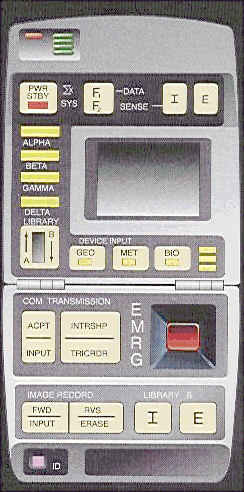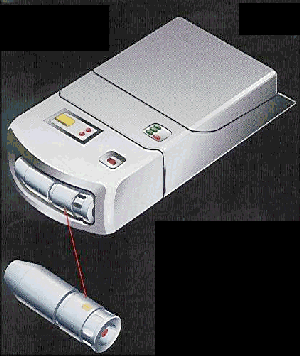




| |

Medical
Tricorders
During
emergencies both on home base and while exploring new worlds, the difference
between life and death for Starfleet personnel often rests in a small,
simple-looking box called the medical tricorder.
![[Medical Tricorder]](images/medtri1.gif) The
underlying design of the medical tricorder is a standard tricorder - a
portable (hand-held) multifunctional device that integrates computers, scanning
sensors, and data storage. Information gathered is analyzed by an internal
computer that also displays the results on a tiny screen built into the
tricorder. The
underlying design of the medical tricorder is a standard tricorder - a
portable (hand-held) multifunctional device that integrates computers, scanning
sensors, and data storage. Information gathered is analyzed by an internal
computer that also displays the results on a tiny screen built into the
tricorder.
The differences between a medical tricorder and the standard model are its
dedicated life-sign sensors, medical analysis computer, and library modules.
To supplement the basic sensors, a stand-alone, close-range hand-held scanner
collects and sends high-resolution readings to the medical tricorder.
Over the last century and a half, standard and medical tricorders have
repeatedly, as powerful technologies emerged, been redesigned and rebuilt from
the ground up. However, the previous descriptions apply equally to both the
first and the newest medical tricorders. Much as the fundamental needs of Constitution-class
starships are still the driving force behind the design of the much-improved Galaxy-class
starships, the mission and the functions of medical tricorders have changed very
little from the 23rd to the 24th century.
The
medical peripheral
Although the size and weight of the tricorder has been shrinking, the current
medical tricorder is the first clam-shell model that folds, via two hinges, for
convenience. The medical peripheral, a clip-on sensor and processing
device, also houses a removable scanner which is capable of extremely detailed
and precise work. The original model was black and rectangular and was carried
by an over-the-shoulder strap; the current model has a total length of just
15cm.
Sensors
In all medical tricorders, sensors detect objects directly in their path to
produce information on the body's overall processes, including electromagnetic
conditions, organ functions, and dangerous organisms. The more powerful the
sensors, the more detailed the data. The 23rd century model only has sensors
situated at the top of the unit. The 24th century medical tricorder coordinates
86 electromagnetic devices that are installed in its internal frame, exterior
sides, and exterior top.
While all medical tricorders allow manual adjustments to system settings and
scanning focus, users of the original models were required to turn mechanical
knobs on the front of the unit. Touch-sensitive buttons covering the face of the
unit have long since replaced these knobs. The current unit also responds to
voice commands.
Storage
An additional advantage of current technology is the vastly expanded retrievable
data and storage capacities. Early models could only integrate eight play/record
disks that were inserted into the front of the unit - lights indicated which
disk was being accessed. Current medical tricorders are outfitted with 14 nickel
carbonitrium crystal wafers, three isolinear optical chips, and an
interchangeable library chip. In practical terms, this means a medical tricorder
contains complete medical data for humans and most humanoid types, plus info on
217 DNA-based species of non-humanoids.
Communications
One major addition to the medical tricorders has been the installation of
multi-tasking communications - the modern medical tricorder and communicator
badge have much in common. Both employ sarium krellide crystals
for power, and can transmit data to and from the ship's computers as long as the
ship is within range. The medical tricorder also has full access to the ship's
medical computers - even during away missions. Further, when utilized on the
ship, the medical tricorder can also tie into computers from other fields.
Easy access to the ship's computers have fundamentally changed how and when the
medical tricorder is used. Previously, doctors relied on medical tricorders only
when separated from sophisticated sickbay equipment. 24th century doctors
classify the medical tricorder as a fundamental tool. Both the first line and
last line of defense, it saves the lives of Starfleet personnel every
day.
Hand
scanner
At times, all versions of medical tricorders need a boost from a hand-scanner -
a device no larger than a small salt shaker. This close-range scanner uses its
power to generate readings more finely tuned than are possible with the
wider-ranging sensors on the medical tricorder itself.
The old tubular-shaped hand scanners gather data with sensors protected by a
tiny mesh screen at one end. At the other end, results are presented in a
minutes version of the readings found above ancient biobeds.
Information from the modern hand scanner - and its 86 embedded high-resolution
devices - is automatically sent to the medical tricorder and integrated with
results already collected. By combining both sets of data, analysis is far more
accurate, an advantage for both doctor and the patient.
 

|